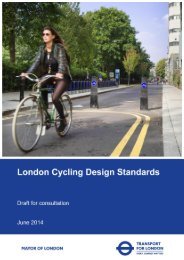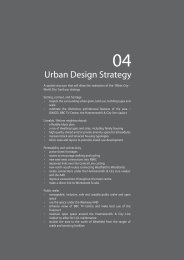Travel in London Travel in London
travel-in-london-report-8
travel-in-london-report-8
Create successful ePaper yourself
Turn your PDF publications into a flip-book with our unique Google optimized e-Paper software.
9. <strong>London</strong>’s air quality and greenhouse gas emissions and transport and public health<br />
These averages do not however reflect the variability between <strong>in</strong>dividual site<br />
characteristics and trends. In addition they reflect all pollution sources experienced<br />
at a monitor<strong>in</strong>g site and not just locally emitted pollution or road based pollution<br />
specifically.<br />
Pollutant concentrations <strong>in</strong> <strong>London</strong> are affected by emissions <strong>in</strong> <strong>London</strong>, pollution<br />
from outside <strong>London</strong> and the UK, and other factors such as weather. Us<strong>in</strong>g<br />
sophisticated statistical models it is possible to ‘remove’ the weather effect from<br />
trends <strong>in</strong> concentrations of the ma<strong>in</strong> pollutants monitored at sites <strong>in</strong> the LAQN.<br />
This allows for the production of trends where the impact of variable weather<br />
conditions is reduced. An analysis recently conducted by K<strong>in</strong>gs College has<br />
quantified the follow<strong>in</strong>g trends between 2008 and 2013:<br />
• Nitrogen Oxide (NO x ) at roadside sites show a downward trend of 1.25 per cent<br />
per year, equivalent to a total reduction over the six-year period of 7.5 per cent.<br />
• NO 2 at roadside sites show a downward trend of 2.1 per cent per year,<br />
equivalent to a total reduction over the six-year period of 12.6 per cent.<br />
• PM 10 at roadside sites show a downward trend of 1.4 per cent per year,<br />
equivalent to a total reduction over the six-year period of 8.4 per cent.<br />
• PM 10 at background sites shows a downward trend of 0.65 per cent per year,<br />
equivalent to a total reduction over the six-year period of 3.9 per cent.<br />
• PM 2.5 at roadside and background sites shows a downward trend of 2.2 per cent<br />
per year, equivalent to a total reduction over the six-year period of 13.2 per<br />
cent.<br />
Variability at <strong>in</strong>dividual air quality monitor<strong>in</strong>g sites<br />
Related to this, K<strong>in</strong>gs College <strong>London</strong> also <strong>in</strong>vestigated the variability <strong>in</strong> changes <strong>in</strong><br />
roadside measurements across the Capital. Specifically this analysis looked at the<br />
difference or ‘<strong>in</strong>crement’ between the roadside measurement and that at an<br />
equivalent background site to quantify the air pollution from traffic as dist<strong>in</strong>ct from<br />
other regional and urban sources.<br />
It is clear from this analysis that the traffic contribution to pollution concentrations<br />
at some sites is improv<strong>in</strong>g much faster than at others. For example, NO 2 and PM 10<br />
concentrations have reduced at Marylebone Road and other sites over the last four<br />
years but this trend has not been seen at all roadside sites <strong>in</strong> <strong>in</strong>ner <strong>London</strong>.<br />
Marylebone Road is not unique <strong>in</strong> display<strong>in</strong>g these air quality improvements.<br />
Understand<strong>in</strong>g the reasons for changes at some sites and not others will provide<br />
evidence on the types of policies and actions that can help reduce pollution across<br />
<strong>London</strong> as a whole.<br />
9.4 Greenhouse gas emissions<br />
Unlike local air quality pollutants, which have direct impacts on the health of the<br />
public, emissions of greenhouse gases such as carbon dioxide (CO 2 ) are of concern<br />
because of their longer-term impact on global climate and the natural environment.<br />
CO 2 reduction target<br />
The Mayor’s Climate Change Mitigation and Energy Strategy (CCMES) set an overall<br />
target to reduce CO 2 emissions <strong>in</strong> <strong>London</strong> by 60 per cent, aga<strong>in</strong>st 1990 levels, by<br />
2025. Transport would be expected to play it’s part <strong>in</strong> achiev<strong>in</strong>g this overall<br />
reduction; however it accounts for slightly more than one fifth of CO 2 emissions<br />
167 <strong>Travel</strong> <strong>in</strong> <strong>London</strong>, Report 8








